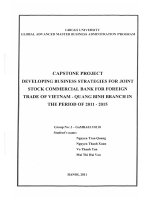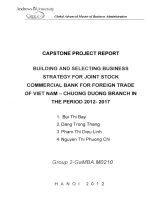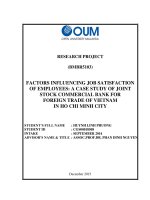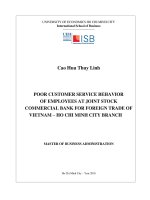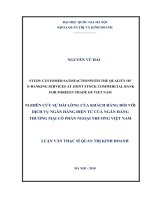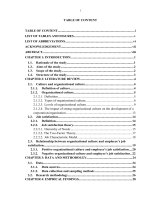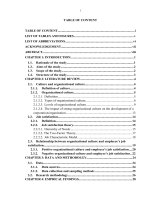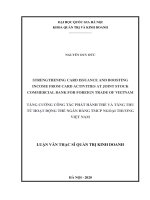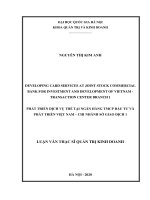An analysis of organizational culture and employee’s job satisfaction at Joint Stock Commercial Bank For Foreign Trade of Vietnam – Vietcombank, Thanh Cong Branch
Bạn đang xem bản rút gọn của tài liệu. Xem và tải ngay bản đầy đủ của tài liệu tại đây (671.72 KB, 107 trang )
i
TABLE OF CONTENT
TABLE OF CONTENT............................................................i
LIST OF TABLES AND FIGURES...........................................iv
LIST OF ABBREVIATIONS...................................................vi
ACKNOWLEDGEMENT.......................................................vii
ABSTRACT.....................................................................viii
CHAPTER 1: INTRODUCTION...............................................1
1.1.Rationale of the study.........................................................................................................1
1.2.Aims of the study................................................................................................................2
1.3.Scope of the study..............................................................................................................2
1.4.Structure of the study.........................................................................................................3
CHAPTER 2: LITERATURE REVIEW.......................................4
2.1.Culture and organizational culture......................................................................................4
2.1.1.Definition of culture.....................................................................................................4
2.1.2.Organizational culture..................................................................................................5
2.1.2.1.Definition............................................................................................................................... 5
2.1.2.2.Types of organizational culture............................................................................................... 6
2.1.2.3.Levels of organizational culture.............................................................................................. 9
2.1.2.3.1.Observable artifacts........................................................................................................ 9
2.1.2.3.2.Espoused beliefs and values............................................................................................ 9
2.1.2.3.3.Basic underlying assumptions....................................................................................... 10
2.1.2.4.The impact of strong organizational culture on the development of a
corporation/organization................................................................................................................. 13
2.1.2.4.1.Attracting and keeping high level talent........................................................................13
2.1.2.4.2.Creating unique manner and brand for each organization.............................................13
2.1.2.4.3.Creating the competitive advantage within the organization.........................................13
2.1.2.4.4.Making job performance within organization more efficient.........................................14
2.2.Job satisfaction.................................................................................................................14
2.2.1.Definition...................................................................................................................14
2.2.2.Job satisfaction theory...............................................................................................15
2.2.2.1.Hierarchy of Needs............................................................................................................... 15
2.1.2.2.The Two-Factor Theory......................................................................................................... 17
2.1.2.3.Job Characteristic Model...................................................................................................... 18
2.2.Relationship between organizational culture and employee’s job satisfaction..................19
2.2.1.Positive organizational culture and employee’s job satisfaction.................................20
2.2.2.Negative organizational culture and employee’s job satisfaction...............................22
CHAPTER 3: DATA AND METHODOLGY...............................24
3.1.Data..................................................................................................................................24
3.1.1.Data sources..............................................................................................................24
3.1.2.Data collection and sampling method........................................................................25
3.2.Research methodology.....................................................................................................26
ii
CHAPTER 4: EMPRICAL FINDINGS.....................................28
4.1.An overview of Vietcombank............................................................................................28
4.1.1.General Information...................................................................................................28
4.1.2.Establishment and Development...............................................................................28
4.1.3.Organizational structure.............................................................................................29
4.2.An overview of Vietcombank, Thanh Cong Branch............................................................31
4.2.1.General Information...................................................................................................31
4.2.2.Organizational structure.............................................................................................31
4.2.3.Business activity.........................................................................................................32
4.2.3.1.Capital raising activity.......................................................................................................... 32
4.2.3.2.Credit activity....................................................................................................................... 32
4.2.3.3.Foreign currency trade......................................................................................................... 33
4.2.3.4.Import-Export payment activity........................................................................................... 33
4.2.3.5.Card and banking card service.............................................................................................. 33
4.2.3.6.Customer development activity........................................................................................... 34
4.2.3.7.Financial result..................................................................................................................... 34
4.3.Organizational culture at Vietcombank, Thanh Cong Branch.............................................34
4.3.1.Types of organizational culture...................................................................................34
4.3.2.Artifact level and its manifestations...........................................................................36
4.3.2.1.Office’s architecture and decoration..................................................................................... 36
4.3.2.2.Brand name, logo and slogan............................................................................................... 37
4.3.2.3.Language and style.............................................................................................................. 38
4.3.2.4.Leadership style................................................................................................................... 39
4.3.2.5.Behavior within branch........................................................................................................ 40
4.3.2.6.Behavior towards customers................................................................................................ 41
4.3.3.Espoused beliefs and values.......................................................................................42
4.3.3.1.Value.................................................................................................................................... 42
4.3.3.2.Attitude................................................................................................................................ 43
4.3.3.3.Business philosophy............................................................................................................. 43
4.3.4.The basic underlying assumptions..............................................................................44
4.3.4.1.Assumptions about External Adaptation Issue.....................................................................44
4.3.4.2.Assumptions about Managing Internal Integration...............................................................44
4.3.4.3.Assumptions about Reality and Truth................................................................................... 44
4.3.4.4.Assumptions about the nature of time and space................................................................45
4.3.4.5.Assumptions about human nature, activity and relationship................................................45
4.3.5.Evaluation of organizational culture at Vietcombank, Thanh Cong branch.................45
4.3.5.1.Strength............................................................................................................................... 45
4.3.5.1.1.The organizational culture is the combination of traditional values and modern values
which are suitable for the development in the open economy....................................................45
4.3.5.1.2.The organizational culture has helped Vietcombank in general and Vietcombank, Thanh
Cong branch in particular create the uniquely competitive advantage and sustainable
development............................................................................................................................... 46
4.3.5.2.Weakness............................................................................................................................. 47
4.3.5.2.1.The resistance to change............................................................................................... 47
4.3.5.2.2.Working styles............................................................................................................... 48
4.3.5.2.3.Awareness of the improvement of organizational culture is not really profound...........48
4.4.Employee’s job satisfaction at Vietcombank, Thanh Cong branch.....................................49
iii
4.4.1.Survey of employees’ job satisfaction at Vietcombank, Thanh Cong Branch..............49
4.4.2.An analysis of job satisfaction at Vietcombank, Thanh Cong Branch..........................50
4.4.3.Evaluation of employee’s job satisfaction at Vietcombank, Thanh Cong branch.........63
4.4.3.1.Strength............................................................................................................................... 63
4.4.3.2.Weakness............................................................................................................................. 66
4.5.Relationship between organizational culture and employee’s job satisfaction at
Vietcombank, Thanh Cong branch..........................................................................................67
4.5.1.Positive employee’s job satisfaction...........................................................................67
4.5.2.Negative employee’s job satisfaction.........................................................................69
CHAPTER 5: CONCLUSION AND RECOMMENDATIONS..........71
5.1.Missions and Goals of Vietcombank, Thanh Cong branch.................................................71
5.2.Recommendations for developing organizational culture and employee’s job satisfaction
at Vietcombank, Thanh Cong branch......................................................................................72
5.2.1.Developing the brand name and image of Vietcombank to the public.......................72
5.2.2.Improving the business ethics among employees and staffs......................................73
5.2.3.Changing the physical working environment..............................................................74
5.2.4.Building the specific value system..............................................................................75
5.2.5.Changing the leadership style to adapt to the environment of all the staffs and
employees at Vietcombank, Thanh Cong branch.................................................................77
5.2.6.Addressing conflict quickly.........................................................................................78
5.2.7.Giving feedback to employees properly.....................................................................79
5.2.8.Developing equal evaluation system..........................................................................81
5.2.9.Encouraging new ideas, creativity and innovation in the branch................................82
5.2.10.Encouraging the collaboration between the members of the branch.......................82
5.2.11.Improving employee’s job satisfaction with pay.......................................................83
5.2.12.Enhancing employee’s job satisfaction with opportunity for training and promotion
84
5.3.A brief summary...............................................................................................................85
CONCLUSION..................................................................87
REFERENCES...................................................................88
APPENDIX 1....................................................................93
APPENDIX 2....................................................................97
iv
LIST OF TABLES AND FIGURES
Figure 2.1: Four types of organizational culture...........Error:
Reference source not found
Figure 2.2: Maslow’s Hierarchy of Needs....Error: Reference
source not found
Figure 4.1: Organizational structure at Vietcombank....Error:
Reference source not found
Figure 4.2: Organizational structure at Vietcombank, Thanh
Cong branch.....................Error: Reference source not found
Figure 4.3: Logo Vietcombank....Error: Reference source not
found
Figure 4.4: Regression Standardized Residual.............Error:
Reference source not found
Table 2.1: Frederick Herzberg's Two-Factor Theory.......Error:
Reference source not found
Table 4.1: Demographic classification according to groups at
Vietcombank, Thanh Cong branch.. . .Error: Reference source
not found
Table 4.2: Descriptive Statistics for 6 factors affecting
employee’s job satisfaction at Vietcombank, Thanh Cong
branch.............................Error: Reference source not found
Table 4.3:Cronbach’s Alpha coefficients and the number of
observation variables ........Error: Reference source not found
Table 4.4: KMO and Bartlett's Test....Error: Reference source
not found
Table 4.5: Total variance explained...................................57
Table 4.6: Correlation matrix............................................59
Table 4.7: Linear regression model...................................61
v
Table 4.8: R square..........................................................62
Table 4.9: ANOVA............................................................62
vi
LIST OF ABBREVIATIONS
ATM
Payment acceptance point –
Automated
Teller Machine
BOD
Board of Director
CEO
Chief Executive Officer
JCM
Job Characteristics Model
JDI
Job Descriptive Index
HOSE
Ho Chi Minh Stock Exchange
MSQ
Minnesota Satisfaction Questionnaire
UNESCO
United Nations Educational, Scientific and
Cultural Organization
USD
United States Dollar
Vietcombank
Joint Stock Commercial Bank For Foreign
Vietcombank,
Trade of Vietnam
Joint Stock Commercial Bank For Foreign
Thanh Cong branch
Trade of Vietnam, Thanh Cong Branch
VND
Vietnamdong
vii
ACKNOWLEDGEMENT
This graduation thesis is the final result of a long process of research and
writing. During the time of conducting this thesis, I know that the successful
completion of this dissertation would be impossible without the support and
corporation of many people to whom I will be forever grateful.
First and foremost, special mentions and grateful thanks must go to Mrs. Le
Thu Hang, my supervisor at Hanoi Foreign Trade University. I’m indebted to her
inspiration and intellectual support throughout the course of writing this graduation
paper. I could not have been able to complete this thesis without her positive
suggestions and guidance. Her continual encouragement, careful reading, critical
comments and patient guidance made my work more enjoyable and easier.
Secondly, I want to thank all the managers and staffs of Vietcombank, Thanh
Cong Branch, for their cooperation that helped and inspired me in writing and for
their willing participation in the study. I greatly appreciate their generosity with
their time and efforts in filling in the questionnaire. Thirdly, I would also like to
give my heartfelt thanks to the authors who provided me with valuable books for
my thesis.
Finally, my appreciation goes to my family, my friends and my classmates.
Their support and constant encouragement gave me a great deal of strength and
determination that help me during the stressful time of writing this paper.
My deepest gratitude is to the readers also, whose feedback will help much
in improving the thesis.
In the future, I hope that with the obtained knowledge, I could apply my
academic knowledge that I have learned at the university to practical problems in
reality.
Hanoi, May 2015
Nguyen Thi Thuy Dung
viii
An analysis of organizational culture and employee’s job satisfaction at Joint
Stock Commercial Bank For Foreign Trade of Vietnam – Vietcombank, Thanh
Cong Branch
ABSTRACT
The graduation thesis represents the analysis and results of research on
impact of organizational culture and employee’s job satisfaction at one of the most
outstanding corporation in terms of banking sector in Vietnam – Joint Stock
Commercial Bank For Foreign Trade of Vietnam (Vietcombank). In this thesis, I use
the case study of Vietcombank, Thanh Cong Branch because this branch may be
given more accurate detailed information.
The first objective of the thesis is to understand the impacts of organizational
culture on the development of Vietcombank, Thanh Cong branch in particular which
also shows the importance of organizational culture for any company in general.
Benefits of adopting organizational culture will create a unique style and attitude for
each company, creating centripetal force for the entire company, helps companies
boost innovation and invention, and attract more customers.
In addition, the second objective of this thesis is to find out the attitudes of
employees towards their jobs while working at any organization through measuring
their job satisfaction. It is also critical which affect to the degree how good the
organizational culture that organization has.
1
CHAPTER 1: INTRODUCTION
1.1.
Rationale of the study
Nowadays, with the rapid development of society, the competition between
companies is more and more severe. Each organization has to set up the unique
strategy to help their corporation survive well in the business environment. One of
the most outstanding factors which help companies to create the critical position in
the customer’s eyes is organizational culture. Recently, this word has not been a
new expression with corporations and public. Many companies have not been afraid
of investing in many resources to form and develop their own culture because they
are aware about the fact that “Making a difference” is a philosophy in business to
improve the image of an organization with society, community and clients. In
general, organizational culture can be understood as all the culture values of an
organization which are shaped, developed, recognized and popularized from years
to years or formed during its development period. It has great influence on all
activities of a company as well as its workers.
Banking industry is a successful industry in interacting with customers and
its success is based on the belief of the clients. Therefore, creating an unique
organizational culture which can make good impression on customers is of greater
importance for banks in general and for commercial banks in particular. Joint Stock
Commercial Bank For Foreign Trade Of Vietnam – Vietcombank is one of the top
leading banks in Vietnam. Developing strong organizational culture is one of the
most strategy that the leaders and officers in that bank strive for.
Besides, a good business environment can become an effective tool to attract
employees and especially help the workers be satisfied with their jobs. Hence, the
organizations can keep the current employees loyal to and dedicated to their
corporation. In return, when the employees are satisfied with their working
environment and job itself, they will devote positively to help their organization go
further steps in the future. As a result, the high rate of job satisfaction will become
the motivation for developing the corporate culture of any organization.
2
Realizing the importance of organizational culture and employee’s job
satisfaction as well as the relationship between these two elements to the
development of the corporation, I decided to choose the topic “An analysis of
organizational culture and employee’s job satisfaction at Joint Stock
Commercial Bank for Foreign Trade of Vietnam - Vietcombank, Thanh Cong
branch” as my graduation thesis topic with the hope that some findings and
recommendations from the study could be a reference to help further developing a
successful corporate culture and job satisfaction for the branch.
1.2.
Aims of the study
The goal of the study is to find out about the organizational culture and
employee’s job satisfaction at Vietcombank, Thanh Cong branch.
To answer this research question, it is necessary to answer the following sub
questions:
•
What is organizational culture?
•
What are the manifestations of organizational culture at Vietcombank, Thanh
Cong Branch?
•
What is employee’s job satisfaction?
•
Which level are employees at Vietcombank, Thanh Cong branch satisfied
about their job?
•
What is the relationship between organizational culture and employees’ job
satisfaction at Vietcombank, Thanh Cong branch?
•
What are the recommendations and solutions for developing organizational
culture and employee’s job satisfaction at Vietcombank, Thanh Cong branch?
1.3.
Scope of the study
This study focuses on the organizational culture and employee’s job
satisfaction at Vietcombank, Thanh Cong branch. Therefore, the scope of the
research is the manifestations contributing the organizational culture and employees
at this branch.
The study analyzes the organizational culture developed by the organization
and the level of job satisfaction at Vietcombank, Thanh Cong branch and gives
some recommendations for the organization to improve its culture and job
satisfaction to make its difference in the eyes of society, community and clients.
3
1.4.
Structure of the study
The thesis includes five main chapters:
Chapter 1: Introduction
This chapter identifies the statement of aims and objectives with clear
indication of the issues, problems and hypothesis being considered.
Chapter 2: Literature review
This chapter gives readers the general knowledge about the objects of the
study. All definitions, forming factors and impacts of corporate culture; definition
and theory of job satisfaction can be found in this chapter.
Chapter 3: Data and Methodology
This chapter presents the research methods as well as data collections. The
manifestations are seen from different perspectives, ranging from visible to invisible
manifestations.
Chapter 4: Empirical findings
Firstly, the organizational culture of Vietcombank, Thanh Cong branch will
be analyzed. The manifestations are seen from different perspectives, ranging from
visible to invisible manifestations. Secondly, the employee’s job satisfaction will be
analyzed based on a survey. Thirdly, the evaluation of organizational culture and
employee’s job satisfaction will be presented. Finally, the relationship between
organizational culture and employee’s job satisfaction at Vietcombank, Thanh Cong
branch can be found out.
Chapter 5: Conclusion and Recommendations
The conclusion is a brief summary of the investigation design and results and
an overall, personal evaluation of the whole study. There are some
recommendations and solutions to further develop the organizational culture and
improve the employee’s job satisfaction at Vietcombank, Thanh Cong branch.
4
CHAPTER 2: LITERATURE REVIEW
This chapter provides background knowledge about the study. It will be
divided into some main parts: the common concepts of the study including the
concepts of culture and organizational culture; the forming factors and the main
impacts of strong organizational culture; the theory of job satisfaction.
2.1. Culture and organizational culture
2.1.1. Definition of culture
Culture is a term that is really familiar with people around the world. We can
see the appearance of things which belongs to culture everywhere. Culture as
concept has had a long-lasting history. The word "culture" derives from a French
term, which in turn derives from the Latin word "colere," which means to tend to
the earth and grow, or cultivate and nurture. "It shares its etymology with a number
of other words related to actively fostering growth," according to Cristina De Rossi,
an anthropologist at Barnet and Southgate College in London. For anthropologists
and other behavioral scientists, culture is the full range of learned human behavior
patterns. The term was first used in this way in the book “Primitive Culture” which
was published in 1871 written by the English pioneer Edward B.Taylor. According
to Hofstede (1980), culture is the collective thinking of minds which create a
difference between the members of one group from another.
Nowadays, the definition of culture stated by Mr. Frederico Mayor, the
General Manager of UNESCO is agreed by our globe. He defines culture as “the
set of distinctive spiritual, material, intellectual and emotional features of society or
a social group, and that it encompasses, in addition to art and literature, lifestyle,
ways of living together, value systems, traditions and beliefs” (Frederico Mayor,
2002).
From these above definitions, culture is summed up, spread and shared from
one generation to others. Culture refers to the all things belonging to knowledge,
experience, beliefs, values, attitudes, meanings, hierarchies, religion, notions of
5
time, roles, spatial relations, concepts of the universe, and material objects and
possessions acquired by a group of people in the course of generations through
individual and group striving.
2.1.2. Organizational culture
2.1.2.1.
Definition
The field of organizational behavior and the related discipline of
management science began investigating organizations in terms of culture as early
as the 1930s. There are various definitions for the concept of organizational culture.
In the book “Understanding organization” written by Charles Handy, organizational
culture is defined as “set of understandings or meanings shared by a group of
people that are largely tacit among members and are clearly relevant and
distinctive to the particular group which are also passed on to new members”
(Charles Handy, 1989, Page 36).
According to Needle (2004), organizational culture represents the collective
values, beliefs and principles of organizational members and is a product of such
factors as history, product, market, technology, and strategy, type of employees,
management style, and national culture.
Ravasi and Schultz (2006) wrote that organizational culture is a set of
shared assumptions that guide what happens in organizations by defining
appropriate behavior for various situations.
However, the most general definition of organizational culture is given by a
professor of organization research in the book “Organizational Culture and
Leadership: A Dynamic View” who defines the culture of a group as “a pattern of
shared basic assumptions that was learned by a group as it solved its problems of
external adaptation and internal integration, that has worked well enough to be
considered valid, and therefore, to be taught to new members as the correct way to
perceive, think and feel in relation to those problems” (Edgar H.Schein, 1992, Page
9)
Organizational culture includes an organization's expectations, experiences,
philosophy, and values. It is expressed in its self-image, inner workings, interactions
with the outside world, and future expectations.
6
Organizational
culture
affects
the
organization’s
productivity
and
performance, and provides guidelines on customer care and service, product safety
and quality, attendance and punctuality, and also the concern for the environment. It
is unique for every organization and one of the hardest things to change.
2.1.2.2.
Types of organizational culture
According to Cameron and Quinn from University of Michigan (1998),
culture defines the core values, assumptions, interpretations and approaches that
characterize an organization. A model of competing values framework was initially
developed on the major indicators of effective organizational performance. This
kind of framework contains four main types of organizational culture as following:
Figure 2.1: Four types of organizational culture
Source: Robert E. Quinn and Kim S. Cameron, 1999
From the Competing Value Framework, 4 types of organizational culture
emerge: Clan – oriented culture, Adhocracy – oriented culture, Market – oriented
culture and Hierarchy – oriented culture. Most organizations develop a dominant
cultural style. Organizations that do not have a dominant culture type either tend to
7
be unclear about their culture, or they emphasize nearly equally the four different
cultural types.
There’s no correct organizational culture for an arts organization. All cultures
promote some forms of behavior, and inhibit others. Some are well suited to rapid
and repeated change, others to slow incremental development of the institution.
i.
Clan oriented culture
Clan culture is the most collaborative and the least competitive of the four
main organizational culture models. According to Cameron, Quinn (1998), typical
characteristics of clan type firms were teamwork, employee involvement programs
and organization commitment to employee. Some basic assumptions in a clan
culture are that the environment can best be managed through teamwork and
employee development, customers are best thought as partners. The organization
emphasizes the long-term benefit of individual development with high cohesion and
morale being important.
Companies in Japan are outstanding example for clan oriented culture.
Unlike American national culture, which is found upon individualism, Japanese
firms approach a more team-centered method. Their clan oriented culture make
organizations operated more like families. They value cohesion, a humane working
environment, group commitment, and loyalty.
ii.
Adhocracy oriented culture
According to Cameron, Quinn (1998), a major goal of adhocracy oriented
culture is to foster adaptability, flexibility and creativity where uncertainty,
ambiguity and/or information overload are typical. An important challenge of these
organizations is to produce innovative products and services and to adapt quickly to
new opportunities. A high emphasis on individuality, risk taking and anticipating the
future exists as almost everyone in an adhocracy becomes involved with production,
clients, research and development and so forth.
High-tech companies like Google are prototypical Create (adhocracy).
Google develops innovative web tools and takes advantage of entrepreneurial
software engineers and cutting-edge technologies. Their ability to quickly develop
8
new services and capture market share has made them leaders in the marketplace
and forced less competition to play catch-up.
iii.
Market oriented culture
The market culture type was based largely on the work of Williamson (1975)
and Ouchi (1981). This culture emphasizes on finishing work, achievement and
getting things done as the long-term goal. People are competitive and focused much
on goals. Leaders are hard drivers, producers and rivals at the same time. They are
tough and have high expectations. The emphasis on winning keeps the organization
together. Reputation and success are the most important things. The organizational
style is based on competition and market leadership.
According to Cameron, Quinn (1998), the market oriented culture also
focuses on transactions with external constituencies including suppliers, customers,
licensees, unions, regulators and so forth. The basic assumptions in a market culture
are that the external environment is quite hostile, consumers are interested in value,
organizations are interested in increasing its competitive position.
iv.
Hierarchy oriented culture
Hierarchy oriented cultures are structured and controlled, with a focus on
efficiency, stability and “doing things right”. According to Cameron, Quinn (1998)
the organizational culture which is compatible with this form is characterized by a
formalized and structured place to work. The long-term concerns of the organization
are stability, predictability and efficiency. Key values centre on maintaining
efficient, reliable, fast, smooth-flowing production.
This is a formalized and structured work environment. Procedures decide
what people do. Leaders are proud of their efficiency-based coordination and
organization. Keeping the organization functioning smoothly is most crucial.
Formal rules and policies keep the organization together. The long-term goals are
stability and results, along with efficient and smooth execution of tasks. Trustful
delivery, smooth planning and low costs define success. The personal management
has to guarantee work and predictability.
9
There are many good examples of organizations with hierarchical cultures
such as McDonald’s (think standardization and efficiency) and Ford Motor
Company with their seventeen different levels.
2.1.2.3.
Levels of organizational culture
2.1.2.3.1.
Observable artifacts
All the phenomena that one can see, hear or feel when he or she encounters a
new group with an unfamiliar culture are the level of artifacts at the surface. They
transmit nonverbal messages or cues that are communicated in a nonlinguistic way.
Organizational culture is deciphered indirectly through artifacts.
At the more visible level, an organization’s culture is determined by the
observable artifacts. Artifacts consist of the physical manifestation of an
organization. They also include the visible products of the group, for instance the
architecture of organization’s physical environment; its language; its technology; its
artistic creations; its style as embodied in clothing, manners of address, emotional
displays, myths and stories; it values, observable rituals and ceremony and so on.
This level also includes the organizational processes by which such behavior is
made routine, and structural elements such as charters, formal descriptions of how
the organization works and organization charts exhibited by people and groups.
Symbols and slogans are high level abstraction of the culture because they
summarize organization’s intrinsic behavior effectively. Slogans are linguistic,
phrase that are intended for the same reason, for example “Customer is King” is a
corporate slogan. Symbols are rituals or incentives that symbolize preferred
behavior”.
Rituals and ceremonies include new hire trainings, new welcome lunches,
annual corporate conferences, awards, offsite meetings and trainings, and so on.
2.1.2.3.2.
Espoused beliefs and values
All groups ultimately reflect someone’s original beliefs and values, their
sense of what ought to be, as distinct from what is. Espoused values represent the
explicitly stated values and norms that are preferred by an organization. Espoused
values are principles or ideas the group articulates or announces publicly as what
10
stand for or what they are trying to achieve. Values consist of vision, mission,
business philosophy and core values.
Vision is the future status that an organization strives for. Vision shows us
common purpose and united activities. It is necessary that corporate vision will be
built first and informed to every member.
Mission includes organizational objectives and method. As long as mission is
identified, an enterprise can reach important goals such as deciding human resource
power, avoiding conflict; setting up extensive border of responsibility.
Business philosophy is philosophic thoughts reflecting business reality by
experiencing, thinking and generalizing of business subjects and then used to
instruct business activities of an organization.
Organization core values are purified essence and are commonly recognized.
It has a huge impact on individual norms, behavior and attitudes. Core values are
similar to rulers of norms of behaviors. Core values are those will never change no
matter how tough a company suffers, unless the enterprise goes bankruptcy or
dissolution.
Beliefs and values will predict much of the behavior that can be observed at
the artifacts level. The true values can only be tested within the organization,
through the employees, based on their collective opinion about the experience of the
values.
2.1.2.3.3.
Basic underlying assumptions
a.
Assumptions about external adaptation issues
The core of culture is represented by basic underlying assumptions which are
difficult to discern because they exit at a largely unconscious level.
•
Shared assumptions about mission and strategy
Every new organization or group must develop a shared concept of survival
problems. In most business organizations, this definition revolves around the issue
of economic survival and growth, which involves the maintenance of good
relationships with major stakeholders of the organization.
Mission relates directly to what organizations call strategy. Strategy is
somewhat should be for any organization to survive and prosper. One of the most
11
central elements of any culture will be the assumptions the members of the
organization share about their identity and ultimate mission or functions.
•
Shared assumptions about goals derived from the mission
Although the core mission is similar, it does not mean that members of a
group will have common goals. In order to achieve consensus on goals, the group
needs a common language and shared assumptions about basic logistical operations.
Senior management can not define clear goals because of lack of consensus
on the meaning of key functions and how those functions reflect the core mission of
the organization. Because operational goals have to be more precise, organizations
typically work out the issues of identity and mission in the context of deciding
annual or longer-range goals. Goals can be defined at several levels of abstraction in
different time horizons.
b.
Assumptions about managing internal integration
Besides accomplishing tasks to adapt to its external environment, a group or
organization must be able to develop as well as maintain a set of internal
relationships among its members. What we ultimately find to be the culture of the
group reflects externally and internally oriented process.
•
Creating a common language and conceptual categories
To function as a group, each individual must come together and establish a
system of communication and a language that permits interpretation of what is
going on.
A common language and common conceptual categories are clearly
necessary for any other kind of consensus to be established and for any
communication to occur at all.
•
Defining group boundaries and identity
If a group or organization need to function and prosper, the most important
areas for clear consensus is the perception of who is in the new group and who is
out, as well as the criteria by which inclusionary decisions are made. As
organization age becomes more complex, the problem of defining clear external and
internal boundaries becomes more and more complex.
•
Developing rules for intimacy, friendship and love
12
Every new group or organization must decide how to deal with authority
problems and how to establish relationship between peers simultaneously. For that
reason, societies develop clear sex roles, kinship systems and rules for friendship
and sexual conduct that serve to stabilize current relationships while ensuring procreation mechanisms and thereby the survival of the society.
c.
Assumptions about Reality and Truth
As groups and organizations evolve, the assumptions they develop about
external adaptation and internal integration reflect deeper assumptions about more
abstract general issues around which humans need consensus in order to have any
kind of society at all. We have many different cultures in the world, and the broader
cultures influence how groups and organizations within them evolve.
d.
Assumptions about the nature of time and space
The perception and experience of time are among the most central aspects of
how any group or organization functions in reality. When people differs each other
in the experience of time, the tremendous communication and relationship problems
typically emerges.
At the level of organization, one can distinguish companies that are primarily
oriented to: the past, thinking mostly about how things used to be; the present,
worrying only how to get the immediate task done; the near future, worrying mostly
about quarterly results and the distant future, investing heavily in research and
development or in building market share at the expense of immediate profits.
e.
Assumptions about human nature, activities and relationship
At the organization level, the basic assumptions about the human nature are
often expressed most clearly in how workers and managers are viewed.
According to Western tradition, we have seen the evolution of assumptions
about human nature, as: Human as rational-economic factors; Human as social
animals with primarily social needs; Human as problem solvers and selfactualizers, with primary needs to be challenged and to use their talents; Human as
complex and malleable (Schein, first published 1965).
Closely connected to assumptions about human nature are shared
assumptions about the appropriate way for humans to act in relation to their
13
environment. The perceived total environment can be controlled (the Western
tradition) or nature must be harmonized with (the assumptions of many Asian
religions and societies), or one must subjugate oneself to nature (the assumption of
some Southeast Asian religions and societies).
2.1.2.4.
The impact of strong organizational culture on the development of a
corporation/organization
Organizational culture is an indispensable part of any corporation. Building a
strong organizational culture brings many advantages as discussed below:
2.1.2.4.1.
Attracting and keeping high level talent
Organizational culture is more than just an internal phenomenon. A good
corporate culture helps company attract the talent and strengthen employee’s
loyalty. An employee will be loyal and want to have a strong attachment to a
company only when he or she is interested in the work. In addition, employees are
encouraged to be apart and raise their own ideas. This encouragement helps
employees proving their own creative abilities, as a base for research and
development process of a company. As a result, the success of workers will create a
diving force which helps to stick them with company for a longer time. In a good
organizational culture, all members have a clear awareness of their roles and assert
themselves, work together to achieve the common goals.
Creating unique manner and brand for each organization
A strong organizational culture will apparently help companies to fulfill their
2.1.2.4.2.
own missions and goals, therefore the brand and manner will be built further and
the fame will increase, too. Organizational culture composes of many elements such
as customs, values, beliefs, business philosophy, and so on. All of these factors
together contribute the style of an enterprise and help to distinguish with other
companies. It is not so difficult to recognize manner and attitude of a successful
corporation. All have a huge effect on the daily operation of the enterprises.
2.1.2.4.3.
Creating the competitive advantage within the organization
The competitiveness of an enterprise can be adjusted in four aspects:
flexibility (the ability of satisfying different needs of customers), the quality of
goods/services (technology characteristic, reliability, industrial design, etc.), the
14
responsible speed in the market (the period of time from ordering to supplying,
speed of developing a new product, etc.), cost (lower than competitors).
Enterprises who want to gain these advantages have to get three important
resources: human resources, capital, technology. The human resources involve
directly adjusting, choosing and developing competitive advantages process of
enterprise. Hence, this resource has the key meaning to the ability of gaining these
advantages. Meanwhile, organizational culture has the first direct effect on each
member of an enterprise, which plays an important role in providing human
resource. So, indirectly, organizational culture can affect the competitive advantages
of an enterprise in the market.
2.1.2.4.4.
Making job performance within organization more efficient
Organizational culture can be a powerful and positive force within an
organization. Culture is an integral part of the process of making individual choices.
It influences what the organization senses, cares about, and is capable of dealing
with. In today’s rapidly changing environment, every organization should try to
provide the best of the best work culture in order to enhance personal effectiveness.
A finding by Barney (1986) has revealed that positive organizational cultures have
been linked to increased staff alignment, resulting in enhanced organizational
effectiveness, increased employee productivity and advanced level of employee
commitment. According to O’Relly (1989), a strong organizational culture enhances
the effectiveness of the staff because they perceive that their actions are freely
chosen. Job performance therefore will be boosted with the sum total of the goals,
productivity, time management, motivation, self discipline, avoidance of
procrastination, good habits, intelligence, organizing power, problem-solving and
decision-making.
2.2. Job satisfaction
2.2.1. Definition
Job satisfaction is not a new issue and its concept has been developed in
many ways by many different researchers and practitioners. One of the most widely
accepted explanations of job satisfaction is that of Locke (1976), who defines job
15
satisfaction as "a pleasurable or positive emotional state resulting from the
appraisal of one's job or job experiences". Additionally, job satisfaction has
emotional, cognitive, and behavioral components (Bernstein & Nash, 2008). The
emotional component refers to feelings regarding the job, such as boredom, anxiety,
or excitement. The cognitive component of job satisfaction refers to beliefs
regarding one's job, for example, feeling that one's job is mentally demanding and
challenging. Job satisfaction scales vary in the extent to which they assess the
affective feelings about the job or the cognitive assessment of the job.
Job satisfaction can be influenced by a person’s ability to complete required
tasks, the level of communication in an organization, and the way management
treats employees. Job satisfaction or Employee satisfaction (also referred to as
morale) is one of the most widely used variables in organizational behavior. It is an
employee's response to his or her organization.
As the definition of satisfaction can be different for different people,
measuring job satisfaction can be challenging and getting different results from
different places. However, most organizations realize that workers’ level of job
satisfaction can impact their job performance, and thus determining metrics is
crucial to creating strong efficiency.
Some factors of job satisfaction may rank as more important than others,
depending on each worker’s needs and personal and professional goals. To create a
benchmark for measuring and ultimately creating job satisfaction, managers in an
organization can employ proven test methods such as the Job Descriptive Index
(JDI) or the Minnesota Satisfaction Questionnaire (MSQ). These assessment help
management define job satisfaction objectively.
2.2.2. Job satisfaction theory
2.2.2.1. Hierarchy of Needs
In 1954, Maslow first published “Motivation and Personality”, which
introduced his theory about how people satisfy various personal needs in the context
of their work. Although commonly known in the human motivation literature,
Maslow’s Hierarchy of Needs theory was one of the first theories to examine the
16
important contributors to job satisfaction. There are 5 levels in Maslow’s Hierarchy
of Needs as following:
Figure 2.2: Maslow’s Hierarchy of Needs
Source: Maslow,1943
This figure demonstrates Maslow’s Hierarchy of Needs according to the
hierarchy. The first level is Physiological needs that include the most basic needs
that are vital to survival, such as the need for water, air, food, and sleep.
The second level is Safety needs that include needs for safety and security
and the needs to be protected from mental damage as well as physical needs are
met.
The third level is social needs that include needs for belonging, love, and
affection.
The fourth level is Esteem needs that include the need for things that reflect
on self-esteem, personal worth, social recognition, and accomplishment.
The fifth level is Self – actualization needs. Self-actualizing people are selfaware, concerned with personal growth, less concerned with the opinions of others,
and interested fulfilling their potential.
Five levels of human needs are described in two groups: lower-order needs
(levels 1 and 2) and higher-order needs (levels 3, 4 and 5). The difference between
17
the two groups is based on the hypothesis that higher-order needs are met from
within, while lower-order needs are met largely from outside.
Maslow's hierarchy of needs theory had been widely recognized and applied
during the 1960s and 1970s (Robins et al., 2008). The weakness of Maslow's
hierarchy of needs is that it fails to provide empirical evidence for the theory and
some researches testing its value did not succeed (Robins et al., 2008).
2.1.2.2. The Two-Factor Theory
Frederick Herzberg's Two-Factor Theory, also known as Motivation-Hygiene
Theory or intrinsic vs. extrinsic motivation states that there are certain factors in
the workplace that cause job satisfaction, while a separate set of factors cause
dissatisfaction. Herzberg distinguishes those measures into two groups: hygiene
factors and motivators as following:

